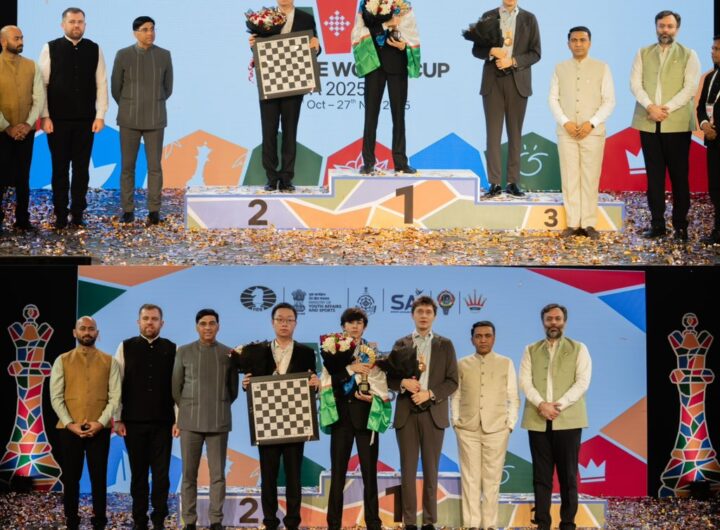 Carlsen Changes Strategy To Draw
Carlsen Changes Strategy To Draw
By Arvind Aaron
Surprise does work well in chess. This time, the surprise came from challenger Magnus Carlsen of Norway. He chose the opening move to keep the quick thinking world champion Viswanathan Anand pause from the very beginning.
Finally, after 33 moves, the players drew a pawn ending when there was no breakthrough possible. Carlsen leads the best of 12 series by 5-3. The first player to reach 6.5 points will win the title. If Carlsen reaches there first, he will become the 20th player in chess history since 1886 to become world champion. If Anand manages to bridge the deficit and retain the title, he will become champion for the sixth time.
Indian fans were also surprised. “I think he could have tried the Sicilian,” said International Master P Konguvel. Asked after the match, Anand said it depends on which Sicilian and there are dry lines in Sicilian also. Perhaps he reeled out his main preparation for the match which was also the Berlin variation of the Ruy Lopez.
With the score reading 2.5-4.5 and facing the white colour, Anand received an opening surprise on move one. Carlsen opened with the king pawn and glanced into the eyes of the champion to see the extent of surprise on the champion’s face. Carlsen who is described by some as an improved version of former champion Anatoly Karpov in playing style did exactly what the former champion did by looking eye on eye.
Earlier, the players arrived to the board with applause from the spectators like in all games. Unlike yesterday, when Carlsen arrived seconds before being disqualified, both players arrived in the hall when it was three minutes to start of play. If both players are not present when the games begin, both will receive ‘zero’ as zero tolerance is in force in FIDE events.
After a two minute pause, Anand went for the Ruy Lopez and chose his line which was also the Berlin variation of the Ruy Lopez. It is significant since Carlsen had also prepared and played the Berlin variation of the Ruy Lopez as black. The whole variation became popular in London 2000 when Kramnik used it to block Kasparov from winning any game. It later got the name, “Berlin wall” after Kramnik’s success.
Game eight can be described as the most insipid encounters of this match. When the expectations run high among Indians and when the pieces get exchanged off the board at regular intervals, such disappointmemts can be magnified. The pawn locked draw broke the hearts of the spectators. Anand is waiting for an opportunity and Carlsen is doing everything he can to slip out.
In the match, Anand needs two wins and two draws from the last four games to take the match to tie-break. Trailing 3-5, and without a victory so far, the asking may be little high. But nothing is impossible in sport. Anand has a rest day on Wednesday before sitting before the white pieces on Thursday.
Anand was asked if he was surprised by white’s first move. He said in a world championship match you had to be ready for any scenario. About 1.e4 he said he had not got it prioritised. “I have a bonus day and can prepare,” said Anand. “I did not mind a draw,” said Carlsen who added, “I set 2-3 traps.” The Berlin variation did not surprise me as he had played it in a few of our previous games, said Carlsen.
The players were subjected to doping test after the eighth game and that accounted for a mild delay in the arrival at the media hall. The tests were done by Dr Jana Bellin. FIDE to be part of the International Olympic Committee initiated doping tests from the Bled Olympiad of 2002. At Bled, the then World No.1 Garry Kasparov who played for Russia said he would never undergo these tests as he does not believe that drugs can enhance chess playing ability due to the the long duration of chess games. In the Bled 2002 Olympiad, Chennai’s women grandmaster Meenakshi was tested for doping after a random pick.
The moves:
White: Magnus Carlsen
Black: Viswanathan Anand
Ruy Lopez C67
1. e4 e5 2. Nf3 Nc6 3. Bb5 Nf6 4. O-O Nxe4 5. Re1 Nd6 6. Nxe5 Be7 7. Bf1 Nxe5 8. Rxe5 O-O 9. d4 Bf6 10. Re1 Re8 11. c3 Rxe1 12. Qxe1 Ne8 13. Bf4 d5 14. Bd3 g6 15. Nd2 Ng7 16. Qe2 c6 17. Re1 Bf5 18. Bxf5 Nxf5 19. Nf3 Ng7 20. Be5 Ne6 21. Bxf6 Qxf6 22. Ne5 Re8 23. Ng4 Qd8 24. Qe5 Ng7 25. Qxe8+ Nxe8 26. Rxe8+ Qxe8 27. Nf6+ Kf8 28. Nxe8 Kxe8 29. f4 f5 30. Kf2 b5 31. b4 Kf7 32. h3 h6 33. h4 h5 Draw.

 Live DGT Board Link for National Women 2025 held at Durgapur
Live DGT Board Link for National Women 2025 held at Durgapur  Certificate of National Under 15 Chess Championship 2025 held in Ghaziabad from 02-10 Nov 2025
Certificate of National Under 15 Chess Championship 2025 held in Ghaziabad from 02-10 Nov 2025  India Registers a Dominant Performance with 49 Medals at the Asian Youth Chess Championship 2025 in Bangkok from 20-30 November 2025
India Registers a Dominant Performance with 49 Medals at the Asian Youth Chess Championship 2025 in Bangkok from 20-30 November 2025  GM Javokhir Sindarov crowned 2025 FIDE World Cup Champion
GM Javokhir Sindarov crowned 2025 FIDE World Cup Champion  Final Report :Commonwealth Chess Championship 2025 in Malaysia from 08-17 Nov 2025
Final Report :Commonwealth Chess Championship 2025 in Malaysia from 08-17 Nov 2025  Certificate :SNA Seminar Held in Andheri on 01 & 02 Nov 2025
Certificate :SNA Seminar Held in Andheri on 01 & 02 Nov 2025